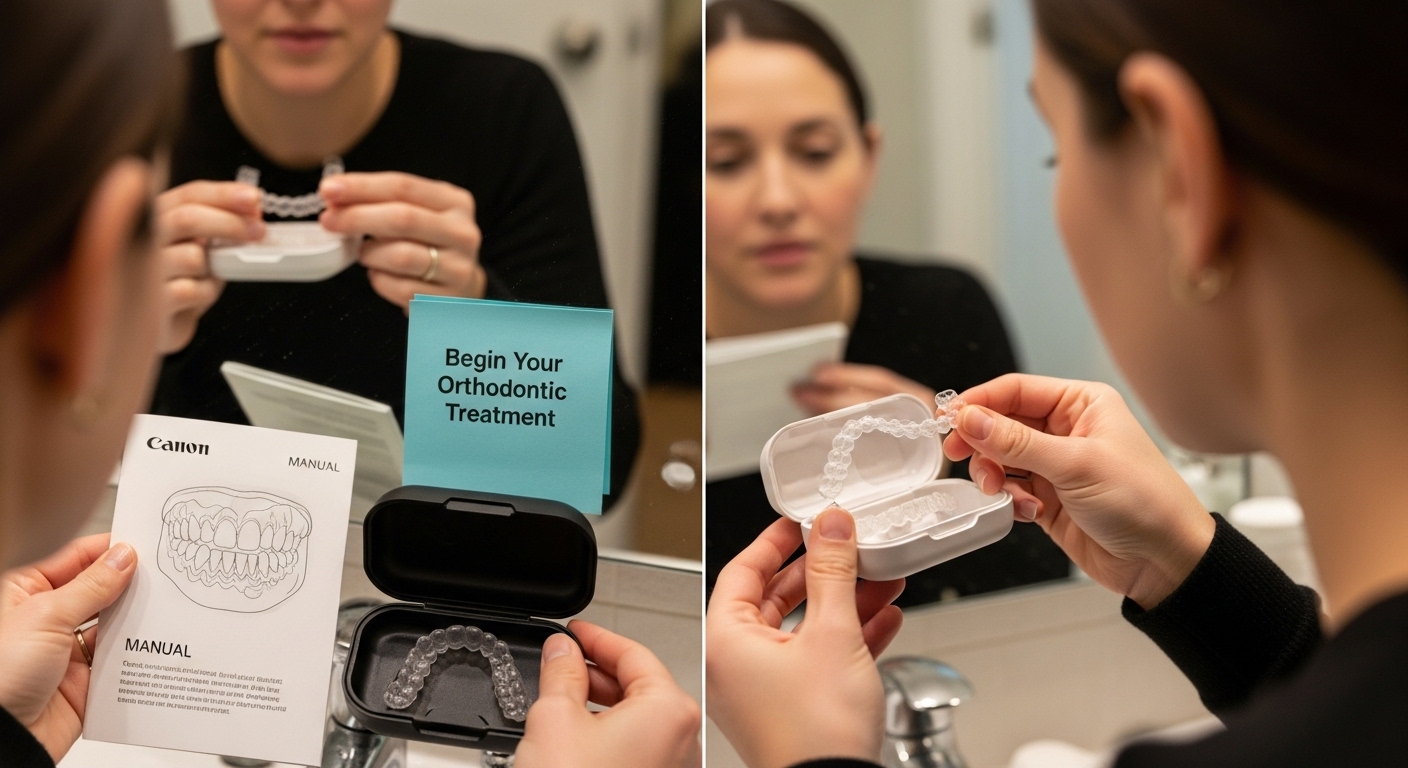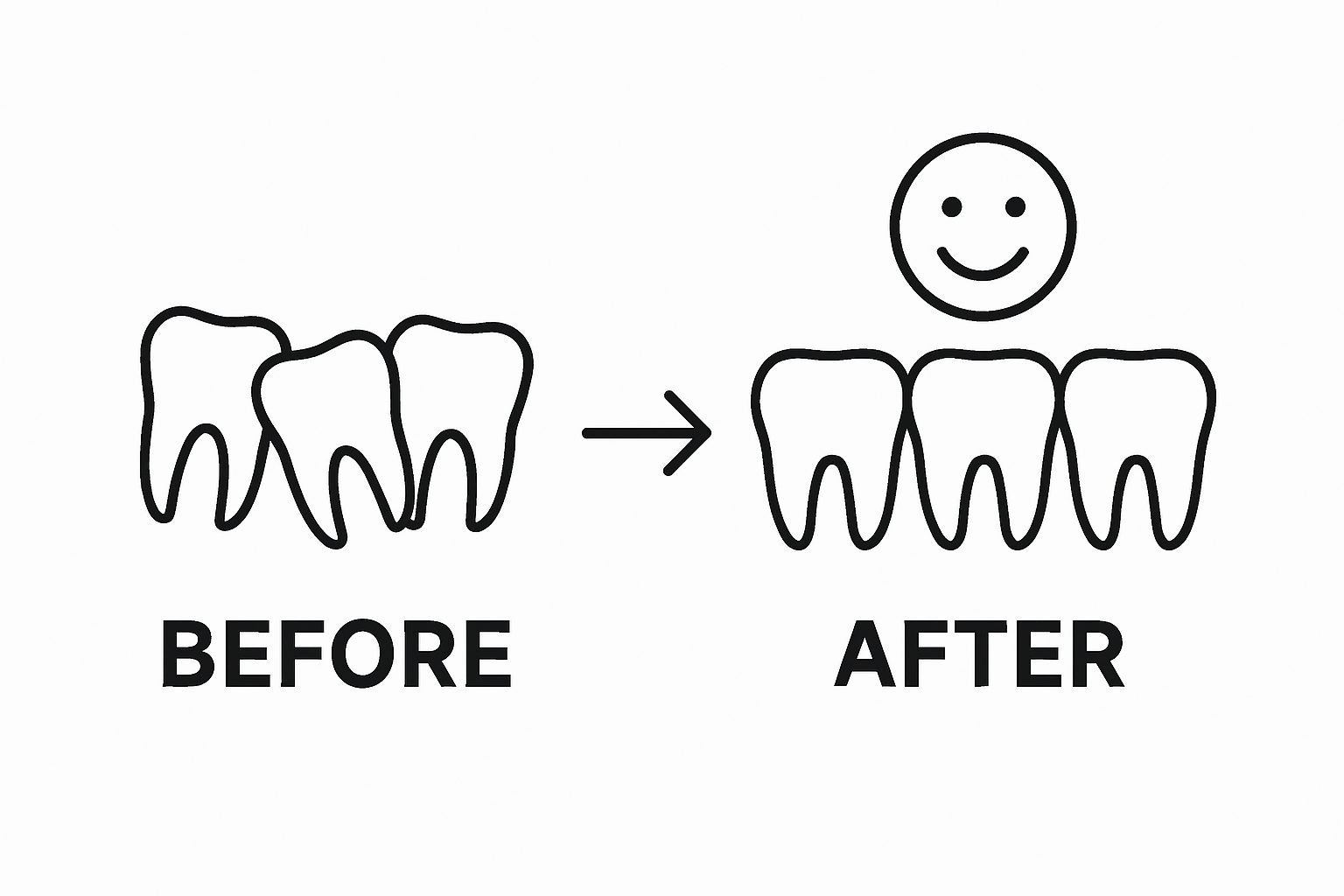Fixing Crooked Teeth: A Step-by-Step Guide to a Confident Smile
September 12, 2025
Fixing Crooked Teeth: A Step-by-Step Guide to a Confident Smile
Crooked teeth do more than just affect your smile.Nearly half of US adults wish they had straighter teeth according to dental surveys, yet most have no idea where to even begin. Many assume fixing misaligned teeth is a hassle only for teens, but adults can actually see stunning results with today’s advanced treatments. The real surprise is that getting a healthy, confident smile might be easier and faster than you ever imagined.
Table of Contents
- Step 1: Evaluate Your Teeth’s Alignment
- Step 2: Research Orthodontic Options
- Step 3: Consult With A Local Orthodontist
- Step 4: Choose The Right Treatment Plan
- Step 5: Begin Your Orthodontic Treatment
- Step 6: Monitor Progress And Adjust As Needed
Quick Summary
| Key Point | Explanation |
|---|---|
| 1. Comprehensive evaluation is essential | A detailed assessment identifies specific alignment issues and guides treatment options for crooked teeth. |
| 2. Research treatment options thoroughly | Understanding various orthodontic solutions helps you choose based on effectiveness, comfort, and lifestyle needs. |
| 3. Prepare well for consultations | Gather dental records and questions to ensure a productive discussion with your orthodontist about treatment plans. |
| 4. Monitor progress with regular check-ups | Ongoing evaluations allow for necessary adjustments, promoting optimal tooth alignment throughout treatment. |
| 5. Clearly understand your treatment plan | Make sure to discuss the timeline, costs, and care instructions to ensure you’re fully informed before starting treatment. |
Step 1: Evaluate Your Teeth’s Alignment
Fixing crooked teeth begins with a comprehensive and professional evaluation of your current dental alignment. This critical first step helps you understand the specific nature of your dental misalignment and determines the most appropriate treatment pathway. Your journey toward a confident smile starts with understanding exactly what corrections are needed.
A professional dental assessment involves multiple diagnostic techniques that provide a complete picture of your teeth’s positioning. During this initial evaluation, an orthodontist will conduct a thorough visual examination, looking closely at how your teeth sit in relation to each other and how your upper and lower jaws align. They will assess potential issues like overcrowding, gaps, rotated teeth, and bite irregularities that might impact your overall oral health.
Diagnostic imaging plays a crucial role in this evaluation process. The American Dental Association recommends comprehensive X-rays and digital scans that reveal detailed information about tooth roots, jaw structure, and potential hidden alignment challenges. These advanced imaging techniques allow orthodontists to create a precise map of your dental landscape, identifying subtle misalignments that might not be immediately visible during a standard visual inspection.
Key aspects an orthodontist will examine during your teeth alignment evaluation include:
- Tooth positioning and individual tooth angles
- Jaw relationship and bite configuration
- Potential crowding or spacing issues
- Overall symmetry of your dental structure
Understanding these details helps determine whether you might benefit from treatments like traditional braces, clear aligners, or other orthodontic interventions. The goal is not just aesthetic improvement but also ensuring proper functional alignment that supports long-term oral health. By completing this initial evaluation, you gain a clear roadmap for transforming your smile and addressing any underlying dental alignment concerns.
After your assessment, your orthodontist will discuss their findings, recommend potential treatment options, and help you understand the expected timeline and potential outcomes. This transparent conversation ensures you can make an informed decision about fixing your crooked teeth with confidence and clarity.
Step 2: Research Orthodontic Options
Researching orthodontic options transforms your approach to fixing crooked teeth from passive to proactive. Understanding the range of treatments available helps you make an informed decision about your dental health and aesthetic goals. This crucial step bridges the gap between your initial evaluation and selecting the most suitable treatment pathway.
Modern orthodontic treatments offer multiple approaches to address dental misalignment. Traditional metal braces remain a reliable option, providing consistent pressure to gradually shift teeth into proper alignment. However, contemporary solutions like clear aligners have revolutionized orthodontic treatment, offering more discreet and flexible alternatives. These innovative systems use custom-designed transparent trays that progressively adjust tooth positioning with minimal visual interference.
The American Association of Orthodontists recommends thoroughly investigating each treatment option’s specific benefits and limitations. Consider factors beyond aesthetics, such as treatment duration, maintenance requirements, comfort level, and potential lifestyle adjustments. Some patients might require additional interventions like spacers, expanders, or even surgical options for complex misalignments.
Key considerations during your orthodontic research should include:
- Treatment duration and expected outcomes
- Cost and potential insurance coverage
- Comfort and visibility of different orthodontic systems
- Maintenance and hygiene requirements
Comprehensive research involves more than online browsing. Schedule consultations with multiple orthodontic professionals to gain personalized insights. Each specialist can provide a unique perspective on your specific dental structure, recommending tailored solutions that align with your individual needs. During these consultations, ask detailed questions about expected results, potential challenges, and recovery processes.
Digital resources and patient testimonials can supplement professional advice, offering real-world perspectives on various treatment experiences. Look for verified patient reviews, before-and-after galleries, and detailed treatment explanations. Your goal is to compile a comprehensive understanding that empowers you to make a confident, well-informed decision about fixing your crooked teeth.
Below is a comparison table of orthodontic treatment options mentioned in the article, outlining their key features to help you make an informed choice.
| Treatment Option | Visibility | Typical Duration | Comfort Level | Suitability |
|---|---|---|---|---|
| Metal Braces | Noticeable | Medium to long term | Moderate | Complex misalignments |
| Clear Aligners | Nearly invisible | Short to medium term | High | Mild to moderate alignment |
| Hybrid Approaches | Varies | Varies | Varies | Special/unique cases |
| Expanders/Spacers | Low to moderate | Variable | Moderate | Supplementary for some cases |
| Surgical Interventions | Not applicable | Case dependent | Depends on case | Severe/complex cases |
Step 3: Consult with a Local Orthodontist
The consultation with a local orthodontist represents a pivotal moment in your journey to fixing crooked teeth. This personalized meeting transforms your research and preliminary evaluations into a concrete treatment plan tailored specifically to your dental needs. Your initial consultation is more than a routine appointment it is a strategic discussion about your oral health and aesthetic goals.
Preparing for your orthodontic consultation requires thoughtful organization. Gather all relevant dental records, including recent X-rays, previous dental treatment history, and a comprehensive list of any dental concerns or sensitivities. Bring a detailed medical history that outlines any existing health conditions, medications, or previous orthodontic treatments. This information provides your orthodontist with a holistic understanding of your dental landscape.
The American Dental Association emphasizes the importance of asking comprehensive questions during your consultation. Come prepared with a written list of inquiries about potential treatment options, expected outcomes, duration, and financial considerations. Your orthodontist will conduct a thorough examination, potentially including digital scans, physical assessments, and bite analysis to develop a precise treatment recommendation.
Key discussion points during your consultation should include:
- Specific treatment recommendations for your dental alignment
- Estimated treatment duration and potential challenges
- Total treatment costs and available payment options
- Potential lifestyle adjustments during treatment
The consultation is your opportunity to establish trust and clarity with your orthodontic professional. Pay attention not just to the technical recommendations but also to the communication style and comfort level you experience. A successful orthodontic journey depends on feeling confident and supported throughout your treatment process.
Verify the consultation’s success by ensuring you leave with a clear understanding of your treatment options, a potential timeline, and a sense of confidence in your chosen orthodontic professional. Take detailed notes, request written treatment summaries, and don’t hesitate to ask for clarification on any aspects of the proposed treatment plan. Your proactive approach during this consultation sets the foundation for a successful path to fixing your crooked teeth.
Here is an at-a-glance checklist table to verify your preparation before your orthodontic consultation, based on recommendations from the article.
| Preparation Task | Description | Why It Matters |
|---|---|---|
| Collect dental records | Gather X-rays and previous dental history | Provides complete clinical view |
| List dental concerns | Document your symptoms or sensitivities | Ensures targeted discussions |
| Prepare medical history | Note medications and existing health issues | Guides safe treatment planning |
| Write down questions | Craft questions about options, results, costs | Encourages informed decisions |
| Organize previous treatments | Note any past orthodontic work | Affects recommendations |
Step 4: Choose the Right Treatment Plan
Choosing the right treatment plan is a critical decision that transforms your dental alignment journey from concept to reality. This step requires careful consideration, balancing medical recommendations with your personal preferences, lifestyle, and financial constraints. Your selected treatment plan will be the roadmap guiding your path to a confident, aligned smile.
Comparing different orthodontic treatments involves analyzing multiple factors beyond simple aesthetics. Traditional metal braces offer predictable results with consistent pressure application, making them ideal for complex misalignments. Clear aligners provide a more discreet option, allowing greater flexibility and minimal visual interference. Some patients might require hybrid approaches or supplementary interventions like dental spacers or temporary anchorage devices.
The Journal of Pharmacy & Bioallied Sciences emphasizes the importance of individualized treatment planning. Your chosen approach should consider your unique dental structure, lifestyle demands, and long-term oral health objectives. A treatment plan is not just about straightening teeth but creating a functional, sustainable solution that supports your overall dental wellness.
Key considerations when selecting your treatment plan include:
- Expected treatment duration
- Total financial investment
- Comfort and aesthetic preferences
- Potential impact on daily activities
Thoroughly evaluate the pros and cons of each recommended treatment option. Request detailed visual simulations showing potential outcomes, and don’t hesitate to ask your orthodontist about alternative strategies. Some patients might benefit from phased treatments that address alignment gradually, while others require more comprehensive interventions.
Verify your treatment plan selection by ensuring you fully understand the proposed approach, have a clear timeline, and feel confident in the expected results. Schedule a follow-up consultation to review the fine details, discuss potential adjustments, and confirm your commitment to the chosen treatment. Your active participation and informed decision-making are crucial in achieving successful dental alignment and a transformative smile.
Step 5: Begin Your Orthodontic Treatment
Beginning your orthodontic treatment marks an exciting transition from planning to active correction of crooked teeth. This pivotal moment represents the start of your transformative journey toward a confident, aligned smile. Your initial treatment session will be comprehensive, involving precise application of orthodontic appliances and establishing a foundational approach to dental realignment.
The first appointment typically involves applying braces or fitting clear aligners with meticulous precision. Your orthodontist will carefully attach brackets, adjust wire tensions, or customize clear aligner trays to ensure optimal tooth movement. Expect a detailed explanation of proper care, maintenance, and potential initial discomfort as your mouth adjusts to the new orthodontic system.
The Healthcare journal highlights that the initial treatment phase involves strategically applying controlled forces to initiate tooth movement. Your orthodontist will map out a precise treatment strategy, considering the unique characteristics of your dental structure and alignment goals.
Key preparation steps for beginning treatment include:
- Stocking up on recommended oral hygiene tools
- Preparing soft foods for initial adjustment period
- Creating a dedicated care routine for your orthodontic appliances
- Scheduling follow-up appointments
Understanding and managing initial treatment expectations is crucial for long-term success. Some patients experience mild discomfort or temporary speech adjustments during the first weeks of treatment. This is normal and typically subsides as your mouth adapts to the new orthodontic appliances. Communicate openly with your orthodontist about any concerns or unexpected sensations.
Verify the successful initiation of your treatment by confirming you understand the care instructions, have your follow-up appointments scheduled, and feel confident in your ability to maintain the prescribed oral hygiene routine. Your commitment during these initial stages sets the foundation for achieving the aligned, beautiful smile you’ve been working toward.

Step 6: Monitor Progress and Adjust as Needed
Monitoring your orthodontic treatment progress transforms fixing crooked teeth from a static process into a dynamic, responsive journey. Regular check-ups and precise adjustments are the cornerstone of achieving optimal dental alignment, ensuring your treatment remains on track and adapts to your unique dental response.
Each follow-up appointment serves as a critical assessment point where your orthodontist evaluates tooth movement, bracket positioning, and overall treatment effectiveness. These consultations involve detailed visual examinations, potential X-rays, and digital scans that track microscopic changes in your dental structure. Your active participation during these appointments is crucial, providing feedback about comfort levels, any unexpected sensations, and your perception of progress.
Scientific research in orthodontic monitoring emphasizes the importance of personalized adjustment protocols. Not all teeth move simultaneously or with identical pressure, requiring nuanced modifications to your treatment plan. Your orthodontist might tighten wires, replace aligners, or recommend supplementary interventions to maintain consistent progression.
Key elements to discuss during progress monitoring include:
- Current tooth movement patterns
- Potential need for treatment modifications
- Maintenance of oral hygiene during treatment
- Expected timeline adjustments
Maintaining open communication with your orthodontic professional is essential during this phase. Be proactive in reporting any discomfort, unexpected shifts, or concerns that arise between scheduled appointments. Some treatments may require more frequent adjustments, while others follow a more predictable progression.
Verify successful progress monitoring by ensuring you understand each adjustment’s purpose, have clear expectations for upcoming treatment stages, and feel confident in your treatment’s trajectory. Your commitment to regular check-ups and willingness to collaborate with your orthodontist will significantly influence the ultimate success of fixing your crooked teeth.

Ready to Start Your Journey Toward a Confident, Aligned Smile?
You have just learned how important it is to evaluate your teeth’s alignment and how choosing the right orthodontic plan can change your life. Many people feel worried about crooked teeth, discomfort, or not knowing where to go next. At Glow Orthodontics, these concerns are met with warmth and expertise, transforming uncertainty into a clear path to your new smile. Choosing effective care in your local community means access to modern solutions like Invisalign, along with proven traditional options, all in a supportive setting.

See real patient stories and discover why so many in Langley trust Glow Orthodontics for honest guidance and tailored orthodontic care. From your first consultation through every visit, you get more than a treatment plan—you get a team devoted to your comfort and progress. Take the next step today, schedule your appointment, and move closer to the confident smile you deserve. Visit our homepage to begin your transformation now.
Frequently Asked Questions
What steps should I take to evaluate my teeth’s alignment?
To evaluate your teeth’s alignment, schedule a comprehensive dental assessment with an orthodontist. This includes a visual examination, diagnostic imaging like X-rays, and discussions about any concerns related to overcrowding, gaps, or bite irregularities.
What orthodontic treatment options are available for fixing crooked teeth?
Treatment options for fixing crooked teeth include traditional metal braces, clear aligners, and other orthodontic interventions. Each option has its own benefits, duration, and comfort levels, so it’s essential to research and consult with an orthodontist to find the best fit for your needs.
How should I prepare for my orthodontic consultation?
Prepare for your orthodontic consultation by gathering relevant dental records, a list of dental concerns, and your medical history. Prepare questions about treatment options, expected outcomes, duration, and costs to discuss with your orthodontist during the appointment.
What should I expect during the initial orthodontic treatment phase?
During the initial orthodontic treatment phase, your orthodontist will apply braces or fit clear aligners. Expect to receive instructions on care, experience some initial discomfort as your mouth adjusts, and schedule follow-up appointments for monitoring your progress.